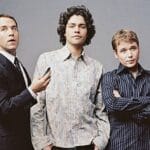Man’s fascination with fictional scenarios is intriguing, especially when compared to the real facts. Conspiracy movies based on true events have raised the bar in the entertainment industry, satisfying audiences seeking knowledge and awareness about mysteries that surround us.
Here are the top 10 TV and movie conspiracy theories that turned out to be true.
The Philadelphia Experiment
In 1984, director Stewart Rafill created “The Philadelphia Experiment,” a film that later won the Best Science Fiction Film Award at the Rome Film Festival. The film centers around events occurring during World War II when U.S. Navy scientists, led by Dr. Franklin Reno, supposedly started a military experiment that aimed to make a warship invisible and able to teleport. The U.S.S. Eldridge, docked in the Philadelphia Naval Yard, was allegedly created in October 1943, but was met with complications.
Legend says sailors on the ship developed extreme conditions, namely mental trauma, seasickness, spontaneous combustion, and even becoming embedded into the warship or invisible. The U.S. Navy has denied all truth behind the Philadelphia Experiment, fueling cover-up speculations. However, the government explained that the experiment aimed to hide ships from magnetic torpedoes during the war. The mysterious venture inspired many movies, including Rafill’s.
The Roswell UFOs
Over 70 years ago, news of a crashed “flying saucer” in Roswell, New Mexico, made the news. The military then changed its story, claiming they had found nothing more than a crashed water balloon, but the retraction did not change anything. One of the most discussed conspiracy theories was born, supported by reports of officials taking aliens to Area 51. By the 1990s, many books, documentaries, movies, and alleged alien autopsy footage had been produced alluding to the U.S. government keeping aliens hidden.
One of the most successful movies about the Roswell UFO incident was Steven Spielberg’s “Close Encounters of the Third Kind.” Released in 1977, the film showcased alien sightings, alien abductions, and conspiracy. The movie even suggested that American scientists had entered into an exchange program with aliens. In 2019, over two million people signed up to storm Area 51 near Rachel, Nevada, hoping to see aliens, even though the event was called a hoax by its organizer.
Men in Black
Referring to UFOs, modern-day theories have taken on a cooler face with the sinister-looking Men in Black. Some people believe that since the 1950s, Men in Black have been present at UFO sightings. Wearing dark suits and driving black Cadillacs, the MiBs are thought to be undercover government agents who silence UFO witnesses. Our understanding of them has evolved with ideas that they could be robots or aliens. In the mid-1950s, ufologist Albert K. Bender said MiBs visited him and ordered him to stop investigating UFOs, believing they were secret government agents whose job was to suppress extraterrestrial evidence.
This idea of the MiBs comes from the 1956 book They Knew Too Much About Flying Saucers by Gray Barker. It’s unconfirmed whether the author believed in his own characters, but he admitted to writing the book for economic reasons. In 1997, director Barry Sonnenfeld’s sci-fi action-comedy “Men in Black” created a blockbuster franchise. We’ve seen these characters before in John Sales’ “Brother from Another Planet” in 1984, and later in “The X-Files.” The “Matrix” also had MiB DNA written all over it.
Moon Explorations
Aside from being one of mankind’s ventures in the 20th century, moon landings were part of the Cold War’s Space Race between the United States and the Soviet Union, leading some to believe that Neil Armstrong’s first moon landing in 1969 was fake. In 2002, French filmmaker William Karel released a mockumentary on the conspiracy between the U.S. government and American film director Stanley Kubrick to fake the landings.
Some people view Karel’s film as a presentation of the truth and often share it on YouTube as evidence. The 2012 documentary “Room 237” focuses on the roles of “The Shining” and Standley Kubrick’s involvement in the landings. In “Apollo 18,” a found-footage sci-fi horror film, the movie suggested that American astronauts did go to the Moon, only to be terrorized by aliens.
Dyatlov Pass Incident
One of the more intriguing theories revolves around the Dyatlov Pass incident. In February 1959, in Russia’s Ural mountains, nine ski trekkers died, sustaining unexplained wounds. Their tents had been ripped open from the inside. It is said the trekkers had come across a top-secret Soviet weapon experiment, and some of the bodies had been radioactively destroyed. The incident inspired books and films, including “The Devil’s Pass,” directed by Rennie Harlin.
Harlin’s movie tells the story of a group of students who investigated the scene of the tragedy years later, capturing the consequences of the failed experiment on camera. While the Russian government recovers and hides the file, hackers manage to get a copy and show it to the public. The film insinuates that a Russian military experiment went wrong, which the government was keeping hidden.
Project MKUltra
MKUltra stands out from most conspiracy theories. It is a confirmed story, making it unsettling. MKUltra, a C.I.A. project started in the 1950s, studied mind control and how certain drugs could alter thoughts and senses. Researchers studied the long-term impact of these drugs on the brain without the participants’ knowledge or approval.
The extent of MKUltra is too comprehensive to be explained in one article, but several documents related to the project no longer exist. The reclassification of some 20,000 files towards the late 1970s confirms the extensiveness of the project. Nonetheless, the 2013 American horror film “Banshee Chapter,” managed to sew all the threads seamlessly despite budget and timeline issues. “The Banshee Chapter” was the critically acclaimed directorial debut of Blair Erickson and was the first to directly reference MKUltra.
John F. Kennedy Assassination
Surveys are still showing that most Americans believe a conspiracy was behind President John F. Kennedy’s assassination. Three decades after the event, Oliver Stone released his film, “J.F.K.” In the movie, Kevin Costner played Jim Garrison, a New Orleans DA who found critical proof that Lee Harvey Oswald was not Kennedy’s only assassin.
After its release, many major American papers claimed Stone was inaccurate about history, including scenes about Kennedy’s vice-president, Lyndon B. Johnson, being part of a coup d’état. These inconsistencies did not stop the movie from gaining praise, especially for its cast’s performances, Stone’s directing, and other technical feats.
The Watergate Scandal
On June 17, 1971, officials caught burglars at the Democratic National Committee Office at the Watergate building complex in Washington. This was the beginning of the Watergate scandal, instigated by former President Richard Nixon, and told by two Washington Post reporters: Bob Woodward and Carl Bernstein. With information from an anonymous whistleblower nicknamed Deep Throat—who was former F.B.I. associate director W. Mark Felt—the journalists exposed Nixon’s part in the conspiracy, leading to his resignation on August 9, 1974.
Woodward and Bernstein won a Pulitzer Prize each for the assignment, which inspired a political biographical drama film in 1976 entitled “All the President’s Men.” Directed by Alan J. Pakula and written by William Goldman, the film starred Robert Redford as Woodward and Dustin Hoffman as Bernstein. The film earned multiple Oscar, Golden Globe, and BAFTA nominations. The Library of Congress preserves it in the United States National Film Registry.
The Rainbow Warrior Conspiracy
Codenamed Opération Satanique, the July 10, 1985 sinking of Greenpeace’s flagship Rainbow Warrior was orchestrated by the French foreign intelligence unit. Two operatives attacked the ship in the Port of Auckland in New Zealand on its way to a French nuclear test protest in Muroroa. Photographer Fernando Pereira was killed in the bombing; he was there to share photos with the world. Pereira drowned on the night of the attack.
France dismissed reports of its involvement, even though New Zealand police caught two of its agents and charged them with arson, conspiracy to commit arson, murder, and willful damage. The controversy resulted in the resignation of French Defense Minister Charles Hernu. The captured agents pleaded guilty to manslaughter and received a jail sentence of ten years each, but were released two years later by the French government. In 1993, Michael Tuchner directed a made-for-TV drama film entitled “Rainbow Warrior,” also called “The Sinking of the Rainbow Warrior,” starring Jon Voight and Sam Neill.
A Pararescueman’s Medal of Valor
In a Vietnam War rescue mission on April 11, 1966, U.S. Air Force Pararescueman William H. Pitsenbarger saved the lives of more than 60 men. Climbing out of his rescue helicopter, Pits joined the people on the ground to help them. After saving several people, he could have escaped but chose to stand behind his fellow soldiers before making the ultimate sacrifice.
“The Last Full Measure,” a 2019 American war drama film directed by Todd Robinson, followed Pentagon staffer Scott Huffman’s efforts to investigate a Medal of Honor request for Pitsenbarger in 1998. As Huffman gathered testimonies from Army veterans, he learned of a conspiracy that had kept the Vietnam War hero from receiving the medal. This prompted Huffman to dedicate his next years to pursuing justice for the fallen airman. Finally, on December 8, 2000, the government awarded A1C William H. Pitsenbarger the Medal of Honor posthumously.
In Conclusion
From hidden government operations to historical cover-ups, these stories teach us to look at the world with a critical eye. Keep exploring, questioning, and seeking the truth behind the narratives presented to us.
What do you think about these uncovered conspiracies? Leave your comments below!










